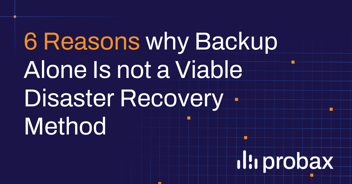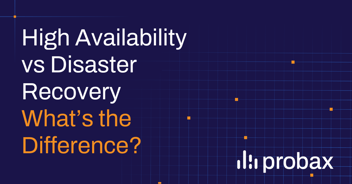As a Managed Service Provider (MSP), discussing the disaster recovery plans and how to implement them with your clients is vital.
Creating a disaster recovery plan requires a dedicated DR team with specialized knowledge in key areas of IT security, management, and compliance.
This helpful guide aims to clarify the importance of creating a disaster recovery team for your MSP clients, its responsibilities, and the roles of each individual on the team.
What is a disaster recovery team?
A disaster recovery team consists of a number of employees whose primary objective is to work together on developing, documenting, and implementing disaster recovery and business continuity procedures.
Assembling a disaster recovery team of qualified individuals is a crucial first step for organizations seeking to develop a new disaster recovery plan or review their current strategies.
When your client assesses candidates to join their disaster recovery team, it’s important to ensure that their experience covers all IT specializations.
What are the responsibilities of a disaster recovery team?
The disaster recovery team's key responsibilities include:
- Oversee data recovery management of all virtual and physical environments
- Carry out risk assessment and mitigation procedures
- Spread awareness and train employees following disasters
- Evaluate historical disasters and identify improvement areas
- Manage DR service vendors and service provider contracts
- Set alerts that notify multiple employees when disaster strikes
- Set roles and duties for each team member to establish accountability, and
- Secure physical locations.
It’s also vital for your client’s disaster recovery team to be knowledgeable in certain technical and administrative areas such as ransomware protection, failover, failback and compliance.
Furthermore, it’s important to distinguish between on-premises and cloud disaster recovery plans as each requires different approaches and resources.
In addition, disaster recovery teams must demonstrate knowledge in the following key areas:
- Staffing
- Security
- Recovery objectives
- Insurance, and
- Communications.
Who should be on a disaster recovery team?
The disaster recovery team consists of department heads, managers, and executives.
Depending on the size of your client’s organization, the team may also include sub-teams.
When establishing a disaster recovery team, it’s important to inform team members of their duties, as well as help them remain up to date with their organization’s policies and procedures.
Disaster Management Executive Committee
The Disaster Management Executive Committee consists of the company’s CEO, senior managers, executives, and in some cases, selected members from the board of directors.
The main duties of the Disaster Management Executive Committee comprise:
- Creating and documenting the company’s disaster recovery plan
- Identifying roles within the committee and the DR team
- Assigning tasks and setting responsibilities for each team member
Disaster Management Team Chairpersons
The Disaster Management Team Chairpersons are tasked with assigning team members for implementing the DR plan created by the executive committee, as well as its associated R&D (Research and Development) responsibilities. They lead and manage the organization’s recovery efforts.
The chairpersons also control the company’s operations and critical business units from the moment of the disaster’s inception all the way to recovering from it successfully.
Business Continuity Experts
The business continuity experts are responsible for ensuring that key business operations remain undisrupted even in case of a disaster.
A business continuity expert should collaborate with other members of the DR team to develop a business continuity strategy that enables the organization to continue its operations normally and be capable of recovering quickly after disasters.
Such a strategy must be aligned with the overall business needs that were identified within the Business Impact Analysis (BIA).
It’s also important for business continuity experts to ensure that the elements of the business continuity plan are taken into consideration in the disaster recovery planning efforts.
Disaster Management Team Coordinators
The Disaster Management Team Coordinators, sometimes also referred to as Crisis Management Coordinator, are responsible for managing and deploying the organization’s recovery techniques. They develop the company’s Disaster Management Plan.
Moreover, the coordinators deploy the decisions made by the executive committee and the chairpersons throughout the disaster.
Disaster Management Team Leaders
The Disaster Management Team Leaders serve as coordinators in their respective departments or areas. They report to the Disaster Management Team Coordinators.
Team leaders are often required in larger organizations with larger DR teams since it can be hard for the coordinators to oversee everything in the DR plan and its implementation.
The Scope of Disaster Recovery
When disaster strikes, your client’s disaster recovery team should be ready to recover their network components and make a successful recovery.
This requires a full understanding of the entire network infrastructure, databases, servers, and equipment.
Network and telecommunication equipment
In case connectivity is disrupted, your client’s DR team should be capable of implementing recovery techniques that get their systems back online while keeping in mind that the problems in connectivity will make team communication more challenging.
Databases
The databases house all the mission-critical data of your client’s organization, and the DR team should have sufficient experience with data protection technologies and techniques.
Servers
The DR team must develop an understanding of your client’s servers and operating systems, as well as identify the most appropriate replication and backup technologies to implement in different scenarios. They should also be able to differentiate between physical and virtual environments and how that affects the overall DR roadmap.
Storage
The DR team must be knowledgeable about virtual and physical storage and the recovery best practices associated with each type.
Disaster Recovery Team Conclusion
To recap, creating a qualified disaster recovery team capable of developing, documenting, and deploying your disaster recovery plan is vital to ensure business continuity and protect yourself from extended downtime and revenue losses.
But it's even more important to choose a trustful disaster recovery partner that securely backs up your organization's mission-critical data and ensures fast and easy accessibility and recoverability in case of disasters.
Contact us now to further discuss your disaster recovery needs and how our cloud DR solutions can help.







